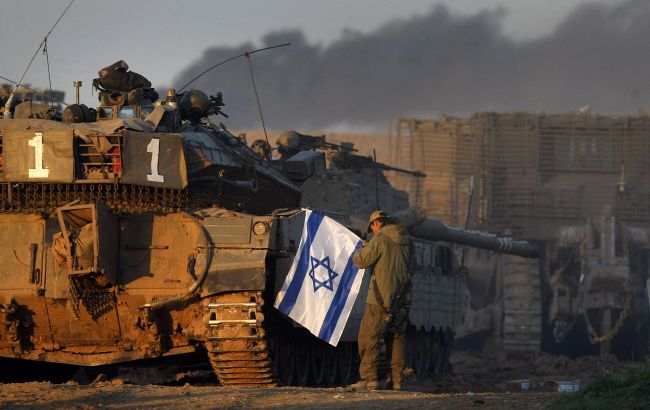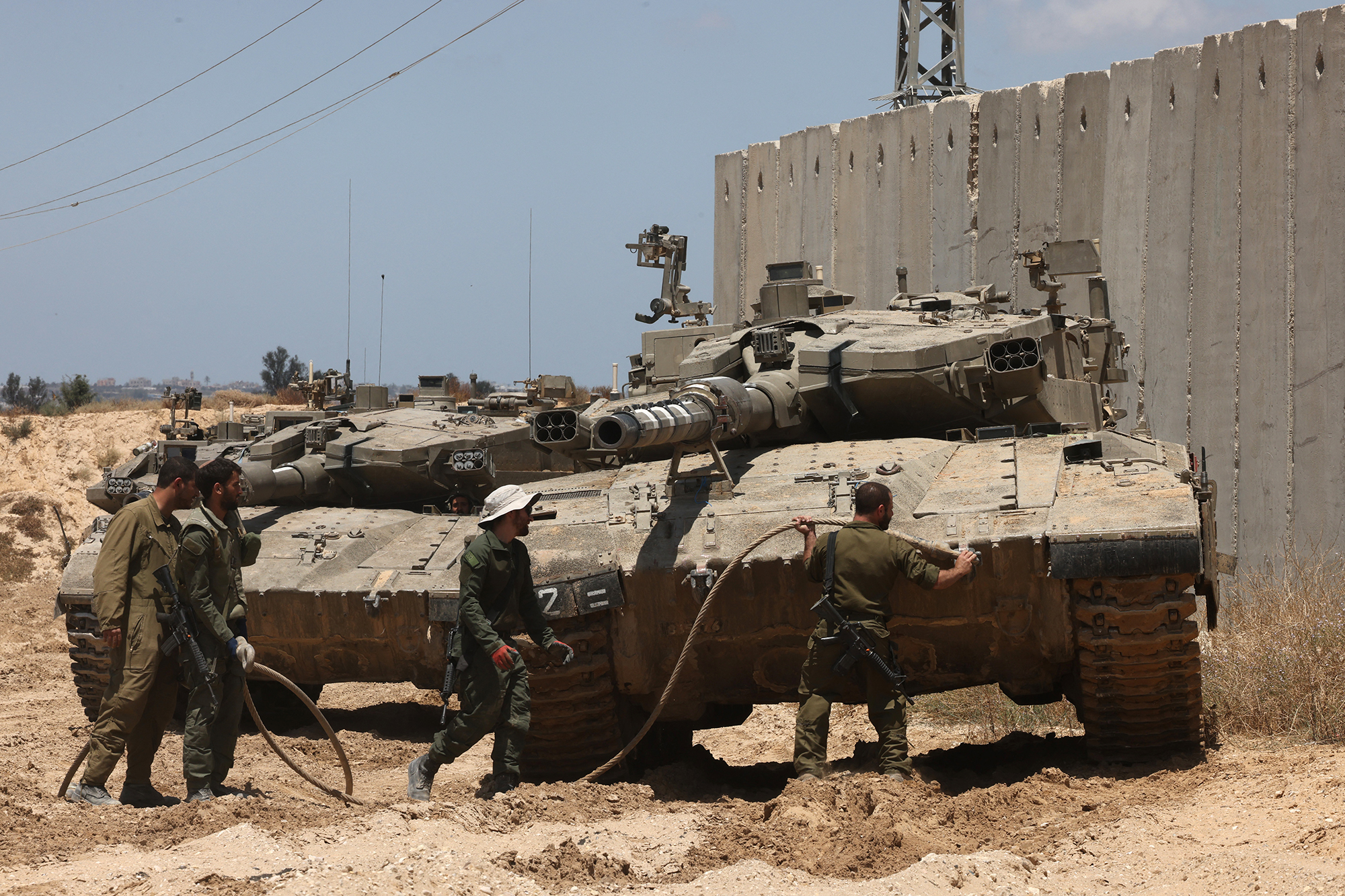Rafah offensive: Current stage of Israel-Hamas conflict and ceasefire prospects
 Photo: The Israel Defense Forces on tanks entered the city of Rafah (Getty Images)
Photo: The Israel Defense Forces on tanks entered the city of Rafah (Getty Images)
The Israeli war against Hamas terrorists has shifted from a potential ceasefire to a new stage of combat operations. Today, the Israeli Defense Forces (IDF) entered the city of Rafah in the southern Gaza Strip and took control of the territory near the border with Egypt.
For more details on the Israeli operation, its objectives, and whether the parties are close to a ceasefire, read the material by RBC-Ukraine.
The material was prepared using information from Reuters, Jerusalem Post, Times of Israel, Vox, statements from Prime Minister Benjamin Netanyahu, and other Israeli officials.
Contents
- Israel's victory would be impossible without it: Main points about Rafah
- What's happening in Rafah
- What is known about Israel's targets
- What's happening with the negotiations and why the parties are far from a ceasefire
Israel's victory would be impossible without it: Main points about Rafah
The operation in Rafah was prepared for several weeks parallel to ceasefire negotiations. The parties failed to reach a common ground, and on the eve, the Israeli Air Force struck terrorist targets in the city in the southern Gaza Strip.
It is estimated that around 1.4 million people are located here, who fled from the northern and central areas of the sector at the early stages of the war.

Photo: One of the last strongholds of Hamas - the city of Rafah - is located in the southern Gaza Strip (map from nyt.com)
The strikes began a day after Israel ordered the evacuation of at least 100,000 Palestinians from the eastern part of Rafah. As a result, footage emerged of families fleeing to the northern districts of the Gaza Strip, which have been heavily affected during nearly 8 months of hostilities.
Rafah is one of the few places where major fighting has yet to occur. It also serves as a border crossing on a crucial route for humanitarian aid. Meanwhile, Israel claims that at least four Hamas battalions are operating here.
The video below shows the evacuation of civilians from Rafah.
A new stage of the war began after a meeting between representatives of Hamas, Israel, Egypt, Qatar, and the USA in Cairo. They sought to negotiate a ceasefire. According to reports, Hamas approved the proposal put forward by Qatari and Egyptian officials, but Israel rejected the plan, citing that it did not align with the initiative of Israeli and US negotiators.
Prime Minister Benjamin Netanyahu had repeatedly warned that the operation in Rafah would take place, as victory would be impossible without it.
In his CNN interview, he drew a parallel between Rafah, where Israel estimates a fourth of Hamas’ fighters are hiding, and the Allied invasion of Berlin in the Second World War. "That’s like leaving a quarter of the Nazi terrorist army in Germany and saying ‘No, we’re not going to finish the last quarter,'" he said earlier.
Considering the destruction in the Gaza Strip and the high number of casualties, international organizations warn of possible tragic consequences. Right now, the vast majority of Gaza's population is concentrated in Rafah, so in the short term, a full-scale operation could lead to a humanitarian catastrophe.
In recent months, Israel has consolidated control over large territories in the sector, including major cities like Gaza and Khan Younis. And since it is convinced that remnants of Hamas terrorists are in Rafah, it sees the offensive as a necessary step toward final victory. Likely, Rafah will become the epicenter of the war for at least the next few weeks.
What's happening in Rafah
On Monday, Netanyahu's office announced the unanimous decision of the military cabinet to conduct an operation in Rafah. The stated goal is to pressure Hamas to release hostages and achieve "other war objectives." Talks for a ceasefire will continue during this time.
A day earlier, Israeli forces dropped leaflets urging civilians to evacuate to a safe zone. This tactic mirrors that used at the beginning of the war when the IDF allowed a 24-hour evacuation period. Currently, it is unknown how many people managed to reach Khan Younis before the operation began.
"IDF forces are attacking and operating now against targets of the terror organization Hamas in a targeted manner in eastern Rafah," said IDF spokesperson Daniel Hagari, commenting on the aerial phase of the offensive.

Photo: Ground operation in Rafah (Getty Images)
During the night of May 7th, airstrikes continued, and artillery also began operating in eastern areas. Around 07:00 a.m., tanks launched an assault on the Rafah crossing near the Egyptian border. Within an hour, it was reported that the 401st Armored Brigade had taken control of the point from the Gaza sector and raised the Israeli flag.
The forces of the 162nd Armored Division are advancing in the eastern part of Rafah, engaging Hamas militants. The 215th Artillery Brigade is targeting infrastructure, including tunnel entrances and mortar positions. The operation also involves the 84th Infantry Brigade.
By morning, the IDF announced the destruction of over 150 targets and control over a strip approximately 3.5 km from the Egyptian border. Dozens of Hamas members have been eliminated, and tunnel shafts have been destroyed. According to military sources, they were part of the terrorists' underground defensive line.
What is known about Israel's targets
The official objective of the operation is to eliminate four Hamas battalions. Israeli representatives claim that around 12,000 militants have been destroyed in the Gaza sector since the beginning of the war. Hamas does not disclose its losses.
Israel also asserts that there are currently six battalions remaining – four in Rafah and two in the central part of the sector. However, it is challenging to assess the accuracy of these claims.
"There's a consensus that Hamas still has at least half of its fighters in the field," on Alterman, director of the Middle East program at the Center for Strategic and International Studies, told Vox.
The objective of the entire Operation Swords of Iron, as the war against terrorists is also called in Israel, is the destruction of Hamas politically and militarily. For this reason, the ceasefire and the release of hostages held since the attack on October 7, 2023, will not expedite the achievement of the goal, as they leave opportunities for Hamas actions in Rafah and the rest of the Gaza sector.
Moreover, the incursion into Rafah creates certain political risks. For example, Egypt threatened to terminate the 10-year peace agreement if Israel dared to advance. Today, the Egyptian Ministry of Foreign Affairs referred to it as a "dangerous escalation." Official Cairo also urged maximum restraint and refraining from steps that could jeopardize a potential ceasefire.
What's happening with the negotiations and why the parties are far from a ceasefire
Israel and Hamas have not agreed on a ceasefire since November when a week-long pause led to the exchange of 105 hostages for 240 Palestinian prisoners. In recent months, the negotiating process has stalled as the parties' positions fundamentally diverge.

Photo: Israeli forces in Rafah intend to destroy remnants of Hamas militants (Getty Images)
According to Reuters, Hamas negotiators have agreed to a three-stage plan. The first two stages, each lasting six weeks, focus on an exchange and IDF withdrawal. The third stage aims at Gaza's reconstruction and ending the years-long blockade. Benjamin Netanyahu referred to this plan as "far from meeting Israel's core demands."
"We are not ready to accept a situation in which the Hamas battalions come out of their bunkers, take control of Gaza again, rebuild their military infrastructure, and return to threatening the citizens of Israel in the surrounding settlements, in the cities of the south, in all parts of the country," he stated.
The Jerusalem Post notes that the US is studying Hamas' proposal and will discuss it with allies in the Middle East. The newspaper also outlines the details of the plan:
Phase One: A 42-day ceasefire and the release of 33 Israeli hostages in a ratio of 30 Palestinian women and children for each. Israel is to begin a gradual withdrawal of its forces from Gaza during this phase.
Phase Two: Another 42-day period with the restoration of "sustainable calm": the withdrawal of the majority of IDF forces and the release of Israeli military personnel in exchange for Palestinians.
Phase Three: Exchange of bodies of the deceased and the beginning of reconstruction according to Qatar, Egypt, and UN plan. It proposes lifting the blockade on the sector and compensating the affected.
At this moment, Cairo is once again hosting delegations from Qatar, the US, and Hamas. A representative of the militants has already threatened that these negotiations could be Israel's "last chance" to release the hostages.
It's worth noting that not everyone in Israel supports negotiations, advocating instead for escalating military pressure on Hamas. For instance, the leader of the Religious Zionist Party and Finance Minister Bezalel Smotrich opposes Israeli delegation participation.
"Sending the delegation to Cairo is a mistake and falls into the manipulative trap set by Hamas together with Qatar and Egypt. This is the time to press more and more on the neck of Sinwar and Hamas until they are destroyed. This is our war of independence and we must win it," he stated, urging that any negotiations be accompanied by military actions.
Meanwhile, the Israeli delegation has indeed arrived in Cairo to discuss the deal. As reported by The Times of Israel, top negotiators were not included in the team, and at this stage, the delegation is represented at a lower level.
According to an unnamed senior official, it will assess whether it's feasible to persuade Hamas to retreat from their latest proposal, which is currently unacceptable to Israel. Obviously, the outcome of today's meeting will determine whether a ceasefire in the Gaza sector is possible at this stage.

